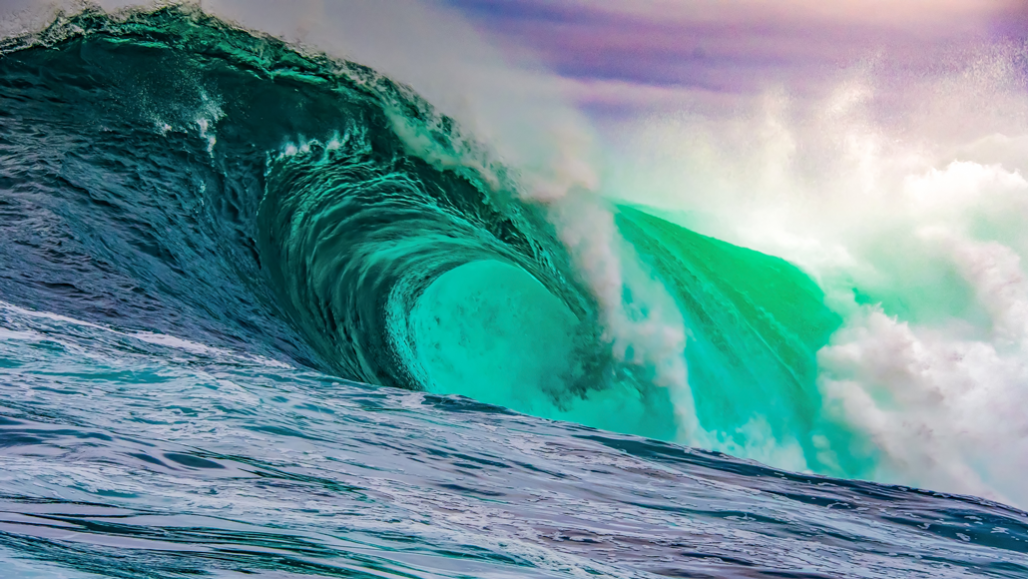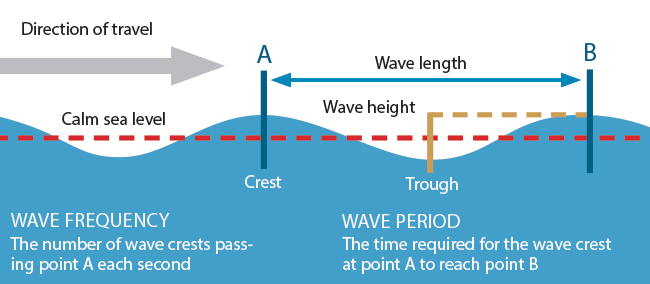Waves Study Guide
INTRODUCTION
You’re on a picnic with your family at the beach. It’s sunny, the water is great, and people are surfing the high waves. You decide to venture a little further into the water until it is chest-deep. A big wave passes over you, picks you up, and sets your right back down where you were standing. Every other wave does the same. So why don’t the waves carry you to the shore although they are moving towards it from the ocean? Let’s find out!
WHAT ARE WAVES?
Everybody has an idea what a wave is. But how would you characterize what defines a wave? In simple terms, a wave can be described as a disturbance that propagates in a medium. The ocean, for example, is a medium through which a wave travels. Waves can travel in air as the medium as well; it is what we call sound! Waves can also travel in all kinds of different materials.
A disturbance is the displacement of the particles in the medium which creates the wave. For example, when you throw a rock into clear water, it creates a disturbance that disperses out as tiny little waves or ripples. Disturbance in the air can be a sudden change of pressure that our ears perceive as sound.
PROPERTIES OF WAVES
To understand waves, it is essential to explore the physical properties of waves.
1. WAVE TYPE
Based on the direction of the displacement of the particles, there are two types of waves: longitudinal and transverse waves.
- In a longitudinal wave, the particles of the medium are displaced in the same direction as the wave’s motion. Example: Waves on slinky and sound waves.
- In a transverse wave, the particles are displaced perpendicular to the direction of wave travel. Examples: Ocean waves.
2. FREQUENCY AND WAVELENGTH
Waves always travel in crests and troughs. The crest is the highest part of the wave, and the trough is the lowest part of the wave. Frequency is the number of crests passing through a point every second. The distance between successive crests or subsequent troughs is called the wavelength of the wave. The height of a crest or the depth of a trough is called the amplitude of the wave.
PROPAGATION OF WAVES
From the types of waves discussed above, we see that a wave is a disturbance in a medium that transports energy through the medium and not matter. That means that the energy traveling through the medium only displaces the particles in the medium from a rest position; it does not cause the migration of the particles to a new location. This is the reason why the waves at the beach lift you and drop you back in the same place as it passes. The wave doesn’t carry you with it to the shore.
CONCLUSION
- Waves are a disturbance in a medium that transports energy through the medium.
- Depending on the displacement of the particles, there are two types of waves: longitudinal and transverse waves.
- Waves only transport energy and not matter.
FAQs:
1. What is wave definition?
A wave is a disturbance in a medium that travels from one point to another.
2. What are 4 types of waves?
The four types of waves include transverse waves, longitudinal waves, and surface waves (mechanical waves). The 4th type of wave is an electromagnetic wave such as light.
We hope you enjoyed studying this lesson and learned something cool about Waves! Join our Discord community to get any questions you may have answered and to engage with other students just like you! We promise, it makes studying much more fun! 😎
SOURCES:
- Types of Waves. https://www.ck12.org/physics/types-of-waves/lesson/Types-of-Waves-PPC/?referrer=concept_details. Accessed 18 Feb 2022.
- Vibrations and Waves – Lesson 1 – The Nature of a Wave. https://www.physicsclassroom.com/class/waves/Lesson-1/What-is-a-Wave. Accessed 18 Feb 2022.
- Waves. https://courses.lumenlearning.com/boundless-physics/chapter/waves/. Accessed 18 Feb 2022.



